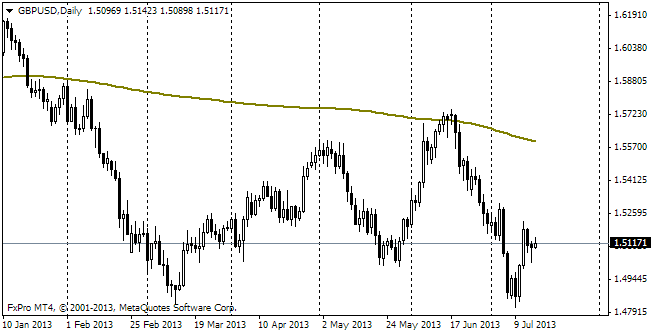EUR/usd
Thursday and Friday ensured a short break for the single currency. Despite the traditionally increased demand for dollars at the end of the month, most players preferred to take profits, giving other currencies a chance to recoup themselves. May is customarily a favourable month for the dollar, and this year hasn't been an exception. In the first days of May the currency dropped from almost 1.400 down to 1.3585 on the speculations around the coming rate cut. The most important thing, in our opinion, was decline below the 200-day MA. Going below this level is able to cause serious strengthening of the bearish camp. Yet, only the ECB's meeting this week will show if it is really so. This meeting will be preceded by a release of inflation statistics, which are also of great importance. Actually, they already won't have any decisive effect on the scale of the ECB's measures to stimulate lending in the region. As is clear from the comments of the Bank's members, both steps to reduce the rates and a possibility to issue loans to the EU banks are considered now. Should the rates be cut, the ECB will be the first large CB which used negative interest rates, charging lending institutions for parking cash in the CB instead of issuing loans to corporations and households. But here we need to consider another variant. If this week's inflation data are as weak as expected, the ECB's hawks will be able to take a firmer position and dissuade from applying such an unexplored measure. Now most conservatives believe that introduction of negative rates may have unpredictable consequences for the markets. Besides, the stats of the EU debt market are also in hawks' favour. The bond yields in this market are much lower than the corresponding ones in the USA and Britain, if we speak about the problem-free countries. But in case with the periphery, which suffered a lot 2-3 years ago, we have the lowest yields on record, comparable with the US rates.
GBP/USD
The BOE's meeting this week doesn't promise anything interesting. There is no chance of a rate increase and the Bank gives comments only in case of changes in the policy. Upon the whole, the sterling is still following the single currency, having gone from the highs of early May at 1.70 down to 1.67 last week. It has a chance to show greater resistance against the dollar than the euro, as the Bank is not expected to ease the policy.

USD/JPY
The support at the 200-day MA has held. The pair has been protected from falling below this level and now it is again trying to get above 102. In the preceding two weeks USD/JPY has failed to stay above this rate for long.

gold
Gold still remains under pressure, making its way to the lows since early February. Over the last week it lost about 50 dollars, going down to 1243. Last year the important support was at 1200. Gold dipped below that level, but invariably came back. Right now it is hard to recommend staking at growth of the instrument. It's better to wait for a more favourable moment, when the season factors will work to support Gold. As practice shows, it happens closer to August.
